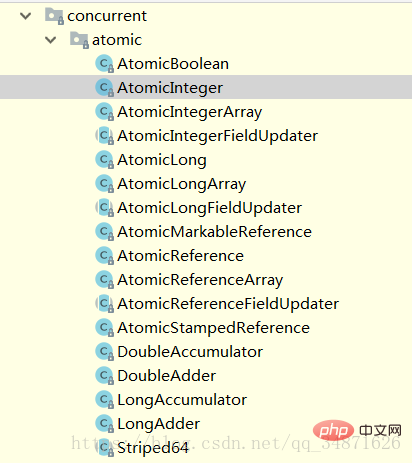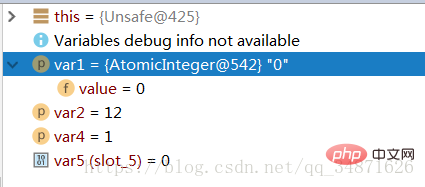當多個執行緒存取某個類別時,不管運行時環境採用何種調度方式或這些進程將如何交替執行,並且在主調碼中不需要任何額外的同步或協調,這個類別都能表現出正確的行為,那麼就稱這個類別時線程安全的。
原子性:提供了互斥訪問,同一時刻只能有一個執行緒對它進行操作
可見性:一個執行緒對主記憶體的修改可以及時的被其他執行緒觀察到
有序性:一個執行緒觀察其他執行緒中的指令執行順序,由於指令重排序的存在,該觀察結果一般雜亂無序
Atomic套件中提供了許多Atomicxxx的類別:

先寫一個簡單範例如下:
@Slf4j
public class AtomicExample1 {
// 请求总数
public static int clientTotal = 5000;
// 同时并发执行的线程数
public static int threadTotal = 200;
public static AtomicInteger count = new AtomicInteger(0);
public static void main(String[] args) throws Exception {
ExecutorService executorService = Executors.newCachedThreadPool();
final Semaphore semaphore = new Semaphore(threadTotal);
final CountDownLatch countDownLatch = new CountDownLatch(clientTotal);
for (int i = 0; i < clientTotal ; i++) {
executorService.execute(() -> {
try {
semaphore.acquire();
add();
semaphore.release();
} catch (Exception e) {
log.error("exception", e);
}
countDownLatch.countDown();
});
}
countDownLatch.await();
executorService.shutdown();
log.info("count:{}", count.get());
}
private static void add() {
count.incrementAndGet();
}
}public class AtomicInteger extends Number implements java.io.Serializable {
private static final long serialVersionUID = 6214790243416807050L;
// setup to use Unsafe.compareAndSwapInt for updates
private static final Unsafe unsafe = Unsafe.getUnsafe();
private static final long valueOffset;
static {
try {
valueOffset = unsafe.objectFieldOffset
(AtomicInteger.class.getDeclaredField("value"));
} catch (Exception ex) { throw new Error(ex); }
}
private volatile int value;
... 此处省略多个方法...
/**
* Atomically increments by one the current value.
*
* @return the updated value
*/
public final int incrementAndGet() {
return unsafe.getAndAddInt(this, valueOffset, 1) + 1;
}
}public final class Unsafe {
private static final Unsafe theUnsafe;
....此处省略很多方法及成员变量....
public final int getAndAddInt(Object var1, long var2, int var4) {
int var5;
do {
var5 = this.getIntVolatile(var1, var2);
} while(!this.compareAndSwapInt(var1, var2, var5, var5 + var4));
return var5;
}
public final native boolean compareAndSwapInt(Object var1, long var2, int var4, int var5);
public native int getIntVolatile(Object var1, long var2);
}假設我們要執行0 1=0的操作,以下是單執行緒情況下各參數的值:


更新後:

下面簡單的示範下Atomic套件下AtomicReference簡單的用法:
@Slf4j
public class AtomicExample4 {
private static AtomicReference<Integer> count = new AtomicReference<>(0);
public static void main(String[] args) {
count.compareAndSet(0, 2);
count.compareAndSet(0, 1);
log.info("count:{}", count.get());
}
}compareAndSet()分别传入的是预期值跟更新值,只有当预期值跟当前值相等时,才会将值更新为更新值;
上面的第一个方法可以将值更新为2,而第二个步中无法将值更新为1。
下面简单介绍下AtomicIntegerFieldUpdater 用法(利用原子性去更新某个类的实例):
@Slf4j
public class AtomicExample5 {
private static AtomicIntegerFieldUpdater<AtomicExample5> updater =
AtomicIntegerFieldUpdater.newUpdater(AtomicExample5.class, "count");
@Getter
private volatile int count = 100;
public static void main(String[] args) {
AtomicExample5 example5 = new AtomicExample5();
if (updater.compareAndSet(example5, 100, 120)) {
log.info("update success 1, {}", example5.getCount());
}
if (updater.compareAndSet(example5, 100, 120)) {
log.info("update success 2, {}", example5.getCount());
} else {
log.info("update failed, {}", example5.getCount());
}
}
}它可以更新某个类中指定成员变量的值。
注意:修改的成员变量需要用volatile关键字来修饰,并且不能是static描述的字段。
AtomicStampReference这个类它的核心是要解决CAS的ABA问题(CAS操作的时候,其他线程将变量的值A改成了B,接着又改回了A,等线程使用期望值A与当前变量进行比较的时候,发现A变量没有变,于是CAS就将A值进行了交换操作。
实际上该值已经被其他线程改变过)。
ABA问题的解决思路就是每次变量变更的时候,就将版本号加一。
看一下它的一个核心方法compareAndSet():
public class AtomicStampedReference<V> {
private static class Pair<T> {
final T reference;
final int stamp;
private Pair(T reference, int stamp) {
this.reference = reference;
this.stamp = stamp;
}
static <T> Pair<T> of(T reference, int stamp) {
return new Pair<T>(reference, stamp);
}
}
... 此处省略多个方法 ....
public boolean compareAndSet(V expectedReference,
V newReference,
int expectedStamp,
int newStamp) {
Pair<V> current = pair;
return
expectedReference == current.reference &&
expectedStamp == current.stamp &&
((newReference == current.reference &&
newStamp == current.stamp) ||
casPair(current, Pair.of(newReference, newStamp)));
}
}可以看到它多了一个stamp的比较,stamp的值是由每次更新的时候进行维护的。
再介绍下AtomicLongArray,它维护了一个数组。在该数组下,我们可以选择性的已原子性操作更新某个索引对应的值。
public class AtomicLongArray implements java.io.Serializable {
private static final long serialVersionUID = -2308431214976778248L;
private static final Unsafe unsafe = Unsafe.getUnsafe();
...此处省略....
/**
* Atomically sets the element at position {@code i} to the given value
* and returns the old value.
*
* @param i the index
* @param newValue the new value
* @return the previous value
*/
public final long getAndSet(int i, long newValue) {
return unsafe.getAndSetLong(array, checkedByteOffset(i), newValue);
}
/**
* Atomically sets the element at position {@code i} to the given
* updated value if the current value {@code ==} the expected value.
*
* @param i the index
* @param expect the expected value
* @param update the new value
* @return {@code true} if successful. False return indicates that
* the actual value was not equal to the expected value.
*/
public final boolean compareAndSet(int i, long expect, long update) {
return compareAndSetRaw(checkedByteOffset(i), expect, update);
}
}最后再写一个AtomcBoolean的简单使用:
@Slf4j
public class AtomicExample6 {
private static AtomicBoolean isHappened = new AtomicBoolean(false);
// 请求总数
public static int clientTotal = 5000;
// 同时并发执行的线程数
public static int threadTotal = 200;
public static void main(String[] args) throws Exception {
ExecutorService executorService = Executors.newCachedThreadPool();
final Semaphore semaphore = new Semaphore(threadTotal);
final CountDownLatch countDownLatch = new CountDownLatch(clientTotal);
for (int i = 0; i < clientTotal ; i++) {
executorService.execute(() -> {
try {
semaphore.acquire();
test();
semaphore.release();
} catch (Exception e) {
log.error("exception", e);
}
countDownLatch.countDown();
});
}
countDownLatch.await();
executorService.shutdown();
log.info("isHappened:{}", isHappened.get());
}
private static void test() {
if (isHappened.compareAndSet(false, true)) {
log.info("execute");
}
}
}以上是怎麼使用Java中的Atomic原子性功能?的詳細內容。更多資訊請關注PHP中文網其他相關文章!




